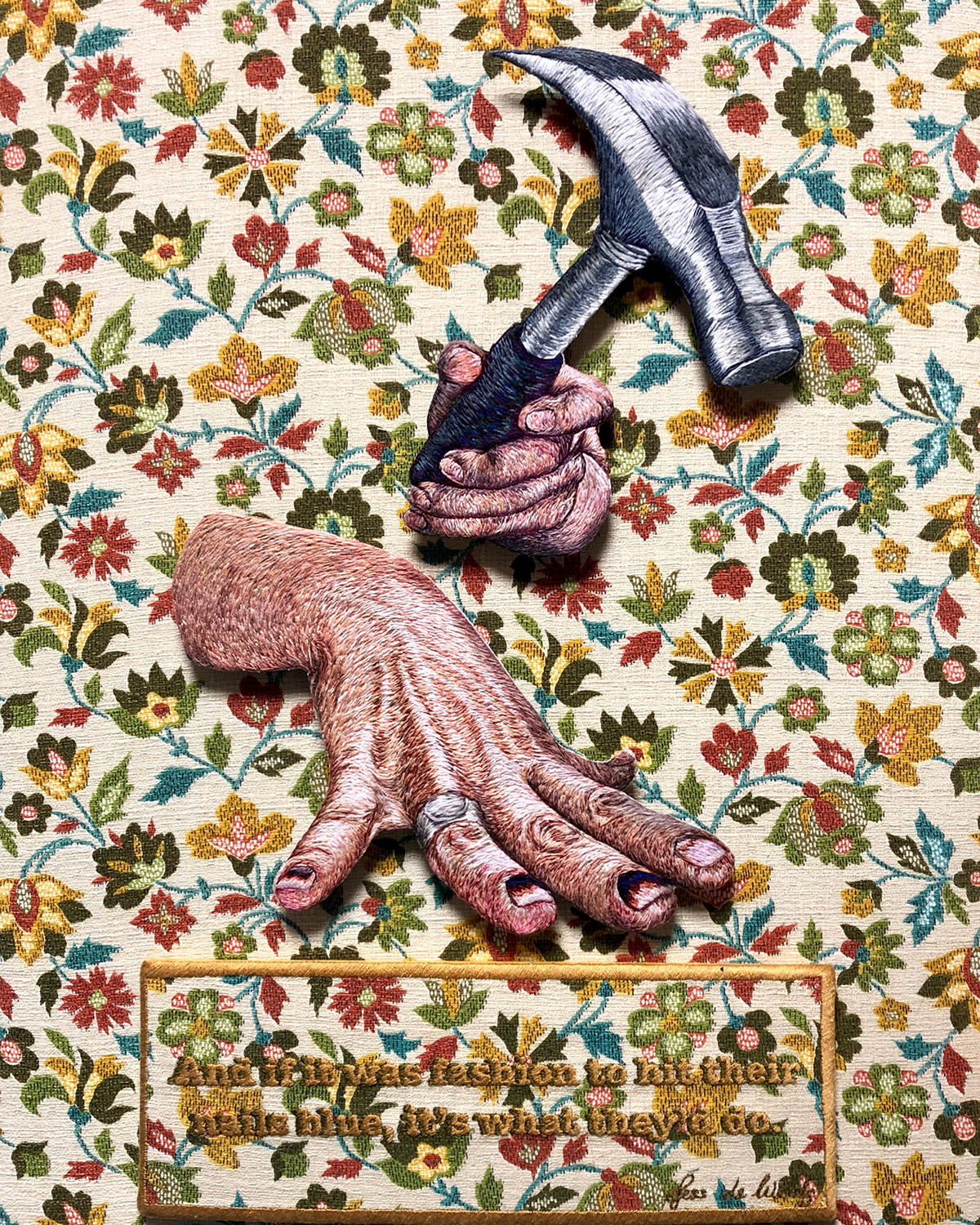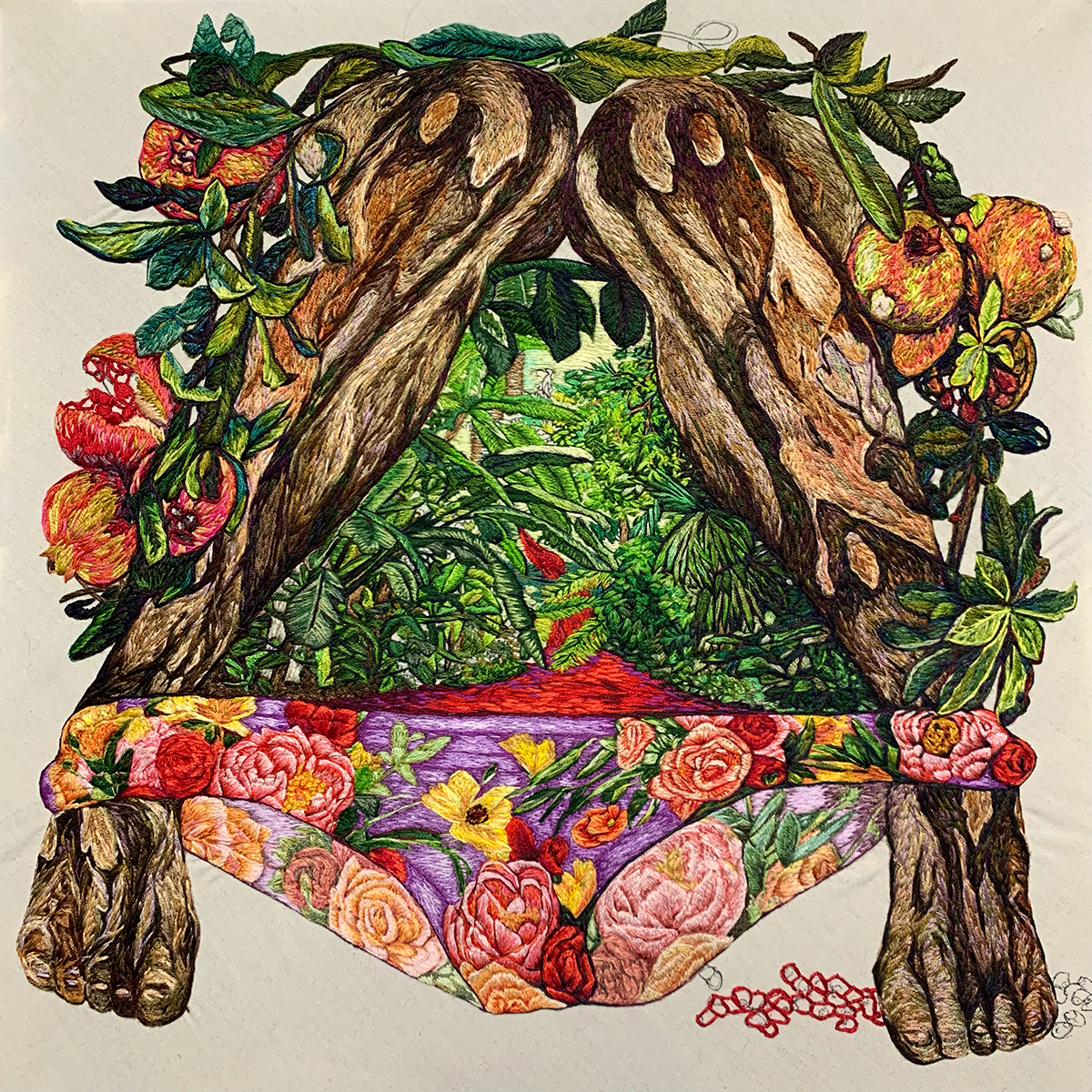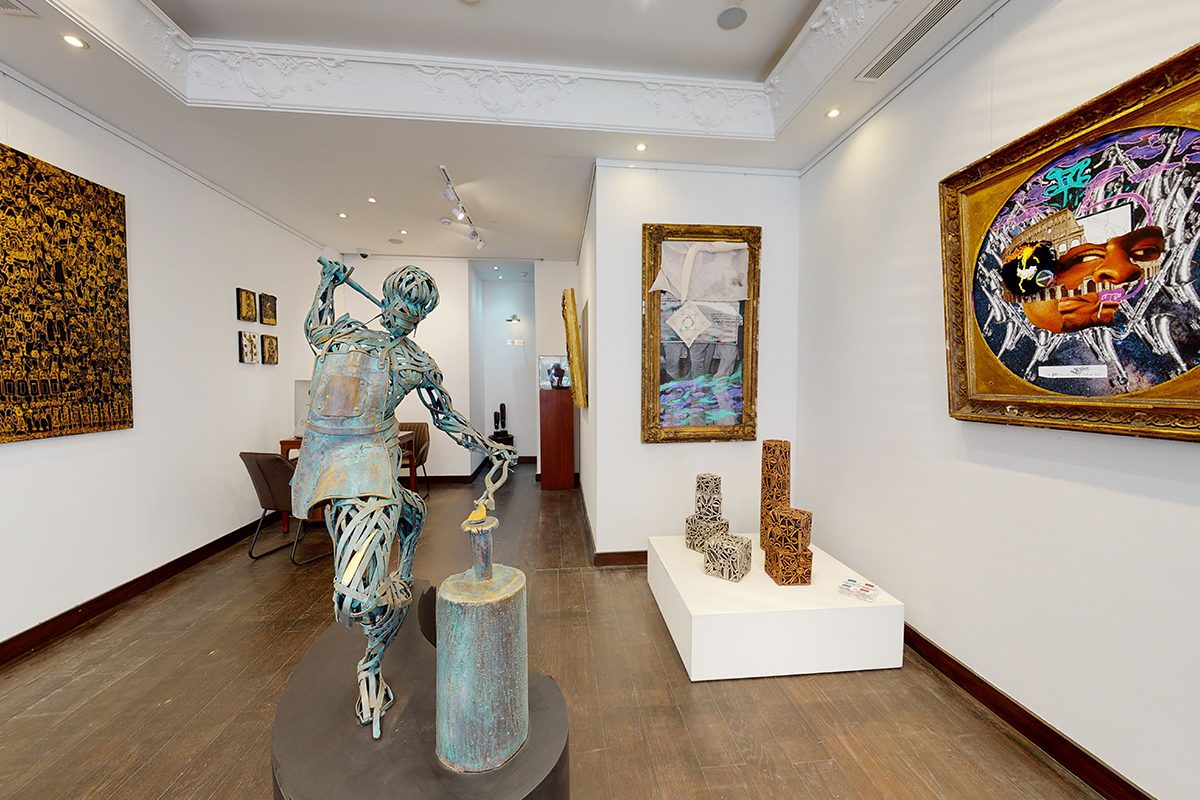
In 2019, German embroidery artist Jess de Wahls had her works removed from the Royal Academy gift shop after a blogpost – in which she outlined her views on gender identity politics – was deemed transphobic. The Royal Academy has since apologised, emphasising the importance of freedom of speech. Here, Candice Tucker speaks to the artist about the experience, her practice and future collaborations
1. You’ve established yourself as an ‘enfant terrible’. Can you explain what that means exactly?
I was branded that, rather, by Hand and Lock, which is this old-fashioned embroidery house in the West End – it’s over 250 years old, I think. I did a bit of work with them over a period of years and I guess it’s because I’m not your average dolly embroiderer. They did a story on me and that’s what it was called and I thought I’ll run with it, it works! I’ve done a lot of vulva embroidery and I’ve got the Big Swinging Ovaries label and I think that’s where it came from and I thought well I guess that’s true because I kind of go against the grain of what people perceive as embroidery.
Follow LUX on Instagram: luxthemagazine
2. Your work explores themes such as the environment, contemporary feminism and female liberation. Do you think there is a natural link between these interests?
There has always been a natural link for me. It wasn’t something I set out to do and embroidery wasn’t something I set out to do either – I just fell into it, naturally.
Traditionally, embroidery and needle work have been seen as women’s work. The recycling bit, for me, is connected in the sense that I am a big fan of trying to reuse things so I almost exclusively work with recycled materials. I embroider onto old fabrics, usually old clothes or bed linen or anything I can get my hands on. When I used to do the Retex sculptures (short for recycled-textile-sculpture) it was purely from donated clothes from friends and family and people that like my work which I cut apart, so that links together with the whole textile aspect.
Feminism was always something I was curious to explore through my work. As mentioned before, embroidery or textile art in general has always been sidelined as women’s work, and regarded as somehow less than mainstream art. I’ve been taking quite a stand over the years now to make a point that embroidery is just as much art as any other medium, but it wasn’t that I thought “I’m a feminist and therefore, I have to choose textile art”, it all just kind of connected. There’s no ulterior motive behind it.

3. How were you first introduced to textile art and embroidery?
I used to paint and draw storyboards, but I sort of fell into textile art when my goddaughter was born and I wanted to make something tactile for so I used some of my old clothes. The last time I had sewn something before that was when I was in primary school. I made a little soft toy for her and I really loved the process of stitching, so much so that I thought, “Why haven’t I done this before?”
After that, I did a lot of sewing which ended up turning into my Retex sculptures that became more and more intricate the more I went with the fabric and the textile. I never studied it so I just found my way through what medium I wanted to work with next. Embroidery happened naturally because the backgrounds got tinier and tinier, and more and more detailed. Now, I pretty much only do embroidery. I find it addictive.
I’ve always been fascinated by meticulous, tiny works of art where there’s lots of repetition, and really, there’s nothing more repetitive than stitching because you get into this flow state and you can go for hours and also do something else whilst you’re doing it. I have a Zoom stitch group – we meet every other day and for 2 hours, we just chat while everybody works on their own projects. It’s kind of like back in the day when women used to meet to stitch. There’s something really soothing about it.
4. How do you think art manages to act as a platform in raising awareness for issues such as equality and the environment?
In a way, I think art has always [raised awareness], it’s just now that the mainstream is taking more notice. Artists have always expressed their worries, concerns, likes, dislikes and fears through their work, but with social media, and the internet, we have much more exposure to [both art and these issues]. Look at Frida Kahlo and her work: she was expressing very similar things early on.
Read more: Helga Piaget on educating the next generation
I do find it a little difficult now because there is so much political art that it becomes a bit like propaganda where I’m not sure how good it is and how much it takes away from the quality of the art. There is also such an incessant need for labels for everyone and everything, which is interesting to me because I’ve sort of become a feminist artist and although the majority of my work is about feminism, it’s also only one of many things that I’m exploring. At the moment, there are a lot of feminist issues that that I’m looking at through my art, criticising or applauding, but that’s not to say that’s what I’ll be focusing on next year when there might be something else that’s more on my radar. There are some really good things about the internet, it allows people to reach broader audiences that they wouldn’t have been able to access before, but [the overload of information and content] can be difficult to navigate.
5. What was the importance of the Royal Academy’s apology with regards to freedom of expression?
Obviously, I welcome the apology. Sadly, over the last two years, I had become almost used to that kind of behaviour. People were really shocked to see what had happened because it was the first time this had happened so publicly, other than what happened with JK Rowling, but that’s a different story because she’s at a different level to me. It was shocking to see that an art institution like the RA would go along with the social media pressure because ultimately that is what it is, and there is a danger in that. I think we should be able to look at art and separate it, to a certain extent, from the artist.
Of course, people are free to disagree with me. They said it’s not freedom of speech if you don’t let people voice their concerns about your views and I’ve never said that they shouldn’t be able to voice them. It’s not freedom of speech if the consequence is that I have to worry about my livelihood and that of my partner and friends. Within art, I think, there are guidelines for hate speech, which I haven’t broken: I don’t hate anyone. So, yes I am glad they apologised publicly. A lot of people were hoping I was going to court, but it’s much more important to have a public stand on this, and I know there are a lot people who disagree with that too, but then, what do you want from art?

Ideas don’t go away just because they are prohibited: they go underground and they fester when they are not being examined. I, as an artist, should be able to say something that isn’t hate speech, and people should be free to say, “That’s rubbish”, or “I agree with you.” To me, that’s what art is about. The way [this whole thing] has been misrepresented as if I am trying to punch down a minority is nonsense: in my opinion, I’m standing up for women. I’ve been open for conversations about my thoughts on this for a long time and they have only every been met with dogma.
If the big art organisations start examining every artist, they won’t have any art on their walls anymore and if only certain thoughts are allowed to be expressed, then we will have a very narrow view of art and life.
6. Do you have any upcoming projects?
I’ve done a couple of webinars with Baroness Nicholson. She wants to get me involved with the Yazidi women in the war camp and bring embroidery there, which I would love to do because in South Africa there are a lot of women who were raped in the war and they work through their trauma with embroidery, which can be super healing and soothing.
There’s also a group of women artists that I’m working with in the background and a couple of curators, we are trying to put on an exhibition about ‘cancelled’ artists, particularly women artists. Who knows, maybe I can convince the Royal Academy to give us a space!
Find out more: jessdewahls.com












Recent Comments